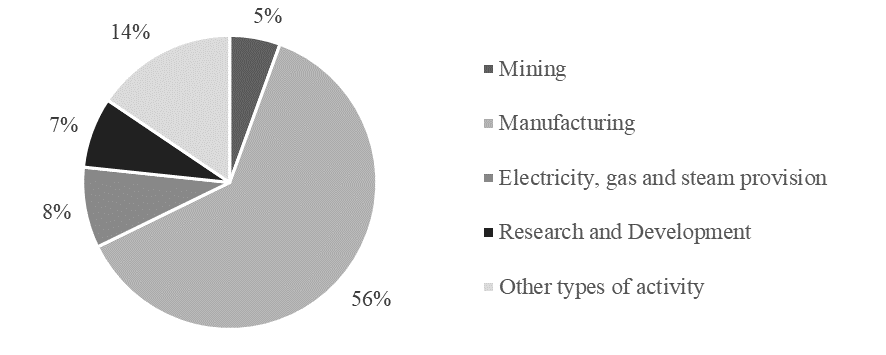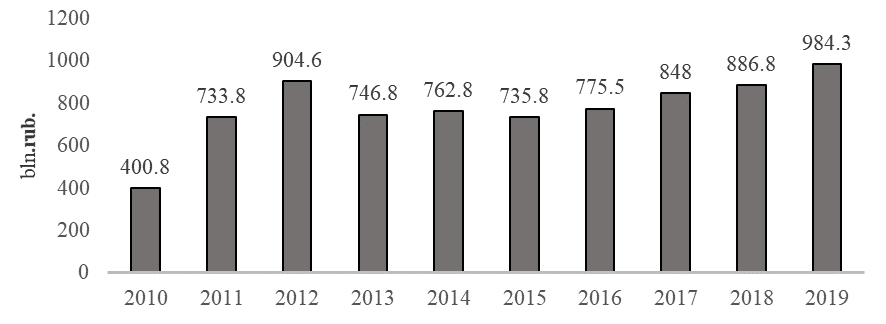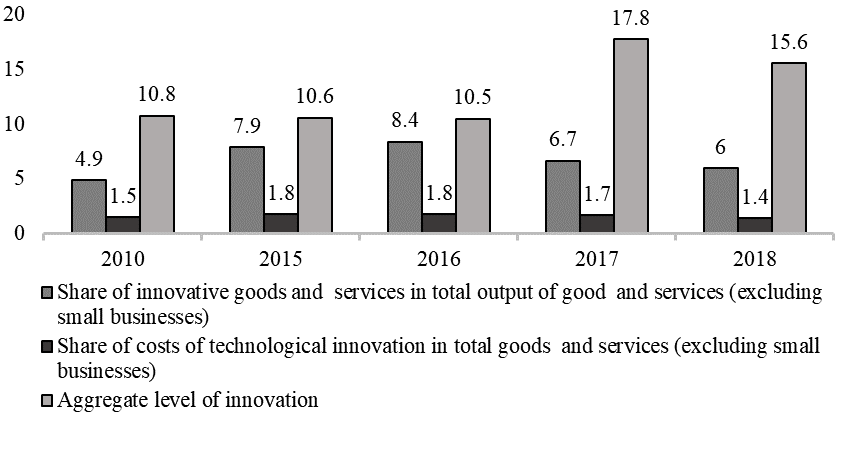Abstract
The intensification of innovative activity in industrial production, taking into account the state's course towards import substitution and overcoming economic sanctions against the Russian Federation from the industrially developed countries of Europe and the United States, contributes to the technological overcoming of the lag in the innovative development of the national economy sectors. The article considers the innovation activity parameters of industrial enterprises on the territory of the Russian Federation and examines the main development trends. The costs of technological innovation and the sources of their financing are also analysed. The main reasons for the decline in innovation activity of industrial enterprises are stated. In addition, the major trends affecting the industrial development are presented. The system improvement of industrial enterprises innovation management based on the project approach is justified. Common characteristics and properties of such concepts as «innovation» and «project» are presented. The project management innovation potential comprehended by the domestic enterprises will contribute to the sustained growth and improved innovation performance.
Keywords: Innovative industry development, innovation management, project
Introduction
The main global trends that are creating new opportunities and challenges both for the Russian economy and individual branches of the economy, including industrial production, comprise the following tendencies:
- the significant impact of technological progress under the conditions of breakthrough developments in artificial intelligence and robotization of operations is becoming not just a factor in the competitive advantage factor for enterprises, but a prerequisite for their development;
- technological innovations stimulate the need for new professions and the acquisition of additional competencies by enterprise managers and employees.
Russia possesses significant scientific and technological potential for the development of the above-mentioned technologies and the conquest of the corresponding high-technology world markets. But their practical application requires a set of institutional solutions aimed at stimulating the innovation and activity of enterprises in the traditional sectors of the economy to which industry has historically belonged» (Business Climate in Industry in August 2020, 2020).
Problem Statement
It is important to note that the impact of the pandemic on the business activity of enterprises in the Russian Federation’s industry has been less significant than in other sectors of the national economy, In other words, the bulk of industrial production in the country is made up of large industrial and strategic enterprises, which received certain support from the state during the crisis in order to reduce the negative economic consequences and to prevent a sharp decline in the number of the employed accounting for 20 per cent of the total economically active population (Trends in Russian Industrial Economics, 2021).
The above-mentioned factors appear to be obvious, however, experts predict the impact of negative trends on the financial and economic outcomes in 2020-2021 (Decree of the President of the Russian Federation from 31.12.2015 N 683, 2016).
Research Questions
Thus, the problem of the innovative way selection crucial for the enterprise development is becoming more urgent since it is supposed to be the driving force for the economic growth and the improvement of the competitiveness not only of a specific economic entity, but also of the country economy taken as a whole. The actual economy sector and new high-tech industries development, position consolidation in the space exploration field, nuclear power engineering, return of leadership in traditional industrial sectors (heavy engineering, aircraft and instrument engineering), rehabilitation of electronic and light industry, vessel and machine-tool construction, as well as statistical assessment systems of the economy branches’ technological development serve as a necessary condition for ensuring the economic security of the country.
Purpose of the Study
The purpose of the study is to assess the innovative state of the industry in the Russian Federation and the factors influencing its development.
Research Methods
Industry occupies an important place in the economy of the Russian Federation accounting for 27 per cent of gross value added, including 14 per cent from manufacturing activities. However, the actual results in the innovative and technological development of Russia are considered to be satisfactory. This particular conclusion is based on the position of the Russian Federation in international ratings, for example, in accordance with the analytical report «Global Innovation Index 2020» (Global Innovation Index, GII) Russia ranked 47th in the overall rating having lost one position as compared to the similar rating of the last year (Cornell University, INSEAD, and WIPO, 2020). New production methods, adoption and the use of advanced technologies are an integral part of the industrial enterprise development. More than 70% of all economic entities using new technologies are the enterprises of the industrial complex (Figure 1).

Russian enterprises are mostly geared to borrowing ready-made technologies, and R&D costs are often considered to be too risky. In «Business Financing of Intellectual Results» in «Global Innovation Index 2020» rating, Russia ranks only 61st. The results of statistical studies carried out by the Higher School of Economics and the Federal State Statistics Service of the Russian Federation also support this conclusion: Almost 30% of the advanced technologies used are acquired abroad, there is a high dependence on imported solutions and low intensity of the development results use (Vlasova & Fursov, 2020). In our view, this is closely related to the high uncertainty of innovation and limited financial resources.
According to Academician Aganbegyan (2012), the average life of technological equipment in Russian industry accounts for about 18 years, while in industrialized countries of Europe and the USA the duration is limited to 8-10 years. The Russian Federation will need from 10 to 12 years and 2 trillion rubles to modernize the capital assets in industry, taking into account the cost of the personnel retraining. The payback period for modernization projects is up to 7 years (Mindeli & Chernykh, 2016). At present, all branches of industry of the Russian Federation face a high deterioration of fixed assets (Table 1).
The cost of developing and implementing technological innovations in industrial production in 2019 amounted to 984.3 billion roubles, having increased by 11 per cent in relation to constant prices over the previous year (Figure 2). The trend over the past nine years has been mixed. In 2015 the funding fell by 3.4 per cent followed by the growth in 2016 - 2019.

The structure of innovation financing is as follows:
- research and development activities of industrial enterprises are financed from their own sources accounting on average 65 per cent of all sources;
- borrowed funds are credited to other financial sources accounting for an average of 22.9 per cent;
- there has been an increase in funding from the federal budget, but only 10 per cent come from budgetary sources;
- the decline in the level of foreign investment as related to the economic sanctions against Russia.
The share evolution of technological innovation costs and the share of innovative goods and services of industrial enterprises is shown in Figure 3.

The period under consideration signifies a slight decline in all indicators stressing the need for additional public support measures.
The enterprise innovation activity can take the form of project management, which presupposes all types of activity within the innovation cycle. This single integrated programme is usually planned and implemented by a specially created group of performers» (Alpysbayev et al., 2019; Oveshnikova et al., 2020).
The analysis of the research process as well as of the regulatory documentation on project management highlights the general properties and characteristics of the project and innovation process presented in Figure 4 (Lyashchenko, 2016; Shamporova & Zubanova, 2016).

Thus, both innovation and project activities have the following features in common:
- target management (in both cases there is a need of a preliminary vision of the potential result for the customer and the initiator in order to formulate the objective of the project and the innovation);
- the identified stages reflecting the process content to achieve the objective (it should be noted that innovation includes the project activity as well);
- the team of professionals with defined competencies for the tasks to be performed (Sorokin, 2017);
- financial and time constraints;
- identification of risks and factors influencing the content of the processes under consideration, uncertainty;
- innovation inherent to the project and innovation activities.
Innovation activity is characterized by high uncertainty, thus, it requires flexible and adaptive management models. Innovation projects are a targeted form of innovation management. There is a direct correlation between the effectiveness of the project management system and the innovation performance of the organization.
Findings
The State prepares legal and regulatory acts concerning innovation activities and measures to support individual branches of industrial production, but the level of innovation activity is rather low.
Radical technological upgrading of production capacities will allow to shift to mass production of innovative products and increase the level of competitiveness for enterprises. Consequently, the main direction of innovation policy in the Russian Federation is an increase in the volume of financing priority directions of research and development.
As experience has shown, innovative industrial enterprises are mainly introducing the technological innovations that ensure the reduction of material costs in production, along with the production of new technological products.
We agree with Mr. Glaziev who claims that R&D financing should come mainly from the federal budget since it is almost impossible to attract investors at this stage due to the uncertainty of the innovation results, At the same time, the access to grant mechanisms is open to enterprises in priority areas (IT, nano-system industry, energy efficiency, etc.). The use of credit facilities for industry is also constrained by poor financial sustainability and profitability which experts estimate to be equal on average to 4 per cent per year. The main reasons for the decline in the level of innovation are reflected in the Consolidated Strategy for the Manufacturing Industry Development of the Russian Federation up to 2024 and 2035, respectively. The following causes are singled out:
- low level of investment in R&D;
- lack of state support for innovation;
- lack of qualified staff;
- low level of interaction between Russian consumers and producers at the development stage (in terms of demand formation and further commercialization), etc.
The above-mentioned factors are relevant not only for manufacturing enterprises but also for all spheres of industrial production in the Russian Federation. A significant increase in research and development activities in industry has been identified by a number of researchers as a key area of industry development (Order of the Government of the Russian Federation from 06.06.2020 N 1512-p, 2020; Vyunova, 2015).
The project approach to innovation will allow to manage the business processes as individual projects to stimulate a more thorough process of innovation search, to provide risk assessment and to overcome the shortage of qualified personnel.
Conclusion
Rapid change of technological layout, selected vector for digitization and automation of production, the urgency to address economic safety and competitiveness issues predetermine innovation in industrial enterprises.
At the present stage of the socio-economic development of the Russian Federation, in the context of economic sanctions and the implementation of the import substitution policy, the main task of economic policy is to bring Russia to an innovative development path using new factors affecting economic growth, which inherent in the digital and information economy.
Stimulating the project activities of the domestic industry is intended to accelerate the processes of import substitution and increase the export potential of the state.
Consequently, in the Russian sphere of project management of the industrial complex, there is a situation when it is necessary to diversify the mechanisms of industrial policy, in accordance with the goals and objectives of foreign economic activity at the present stage of innovative development, based on the technologies of the fifth and sixth technological modes. Significant strengthening of research and development activities in the industry is one of the key areas of its development.
References
Aganbegyan, A. G. (2012). On the modernization of Russian public production. Innovation, 1(159), 31.
Alpysbayev, K. S., Gridneva, Y. E., Kaliakparova, G. S., Saparbayev, A. D., & Assanova, S. S. (2019). Evaluation of influence of innovation on productivity enterprise. Space and Culture, 7(1), 186-193.
Business Climate in Industry in August 2020. (2020). https:/issek.hse.ru/
Cornell University, INSEAD, and WIPO. (2020). The Global Innovation Index 2020: Who Will Finance Innovation? Ithaca, Fontainebleau, and Geneva.
Decree of the President of the Russian Federation from 31.12.2015 N 683. (2016). «On the National Security Strategy of the Russian Federation» Access Mode: Legislative Assembly of the Russian Federation, 04.01.2016, N 1 (Part II), Art. 212.
Mindeli, L. E., & Chernykh, S. I. (2016). Funding of basic research in Russia: Modern realities and forecasts. Studies on Russian Economic Development, 27(3), 318-325.
Lyashchenko, Y. V. (2016). Project Approach to Management in Innovation. Topical Issues in Aviation and Space, 12, 432-434.
Oveshnikova, L. V., Sibirskaya, E. V., Tenetova, E. P., Kuznetsova, N. P., & Grigoryeva, M. O. (2020). Potential Horizons of Technological Development of Russia. Lecture Notes in Networks and Systems, 91, 264-274.
Order of the Government of the Russian Federation from 06.06.2020 N 1512-p. (2020). «On approval of the Consolidated Strategy for Development of the Manufacturing Industry of the Russian Federation until 2024 and 2035» Access Mode: Assembly of the Legislation of the Russian Federation, 15.06.2020, N 24, Art.3843.
Shamporova, Z. E., & Zubanova, A. K. (2016). Project Management of Innovation Activity of Industrial Enterprise. Topical problems of aviation and space, 12, 454-546.
Sorokin, A. (2017). Competence of Project Innovation Management. Science and Innovation, 2(168), 40-43.
Trends in Russian Industrial Economics. (2021). http:///www.rea.ru/ru/Pages/exspertixareu.aspx
Vlasova, V. V., & Fursov, K. C. (2020). Almost 30% of the advanced technologies in Russia are purchased by the bank. https://www.hse.ru/news/science/438571134.html
Vyunova, R. R. (2015). Application of project management in innovation. Heteromagnetic microelectronics, 18, 118.
Copyright information

This work is licensed under a Creative Commons Attribution-NonCommercial-NoDerivatives 4.0 International License.
About this article
Publication Date
25 September 2021
Article Doi
eBook ISBN
978-1-80296-115-7
Publisher
European Publisher
Volume
116
Print ISBN (optional)
-
Edition Number
1st Edition
Pages
1-2895
Subjects
Economics, social trends, sustainability, modern society, behavioural sciences, education
Cite this article as:
Solodova, E., Solovova, N., & Kalmykova, D. (2021). Innovative Industry Development In The Russian Federation. In I. V. Kovalev, A. A. Voroshilova, & A. S. Budagov (Eds.), Economic and Social Trends for Sustainability of Modern Society (ICEST-II 2021), vol 116. European Proceedings of Social and Behavioural Sciences (pp. 1978-1985). European Publisher. https://doi.org/10.15405/epsbs.2021.09.02.222

